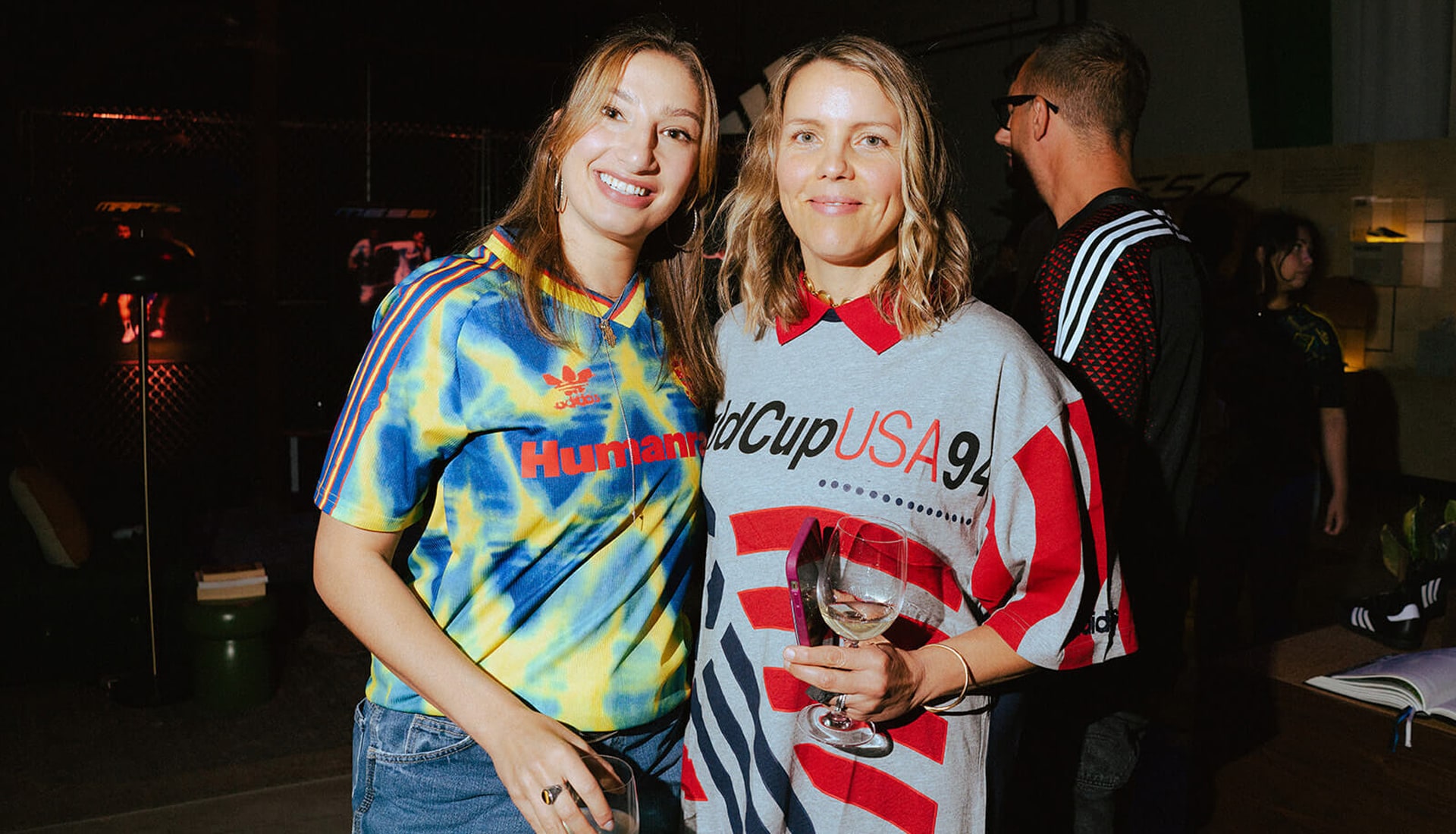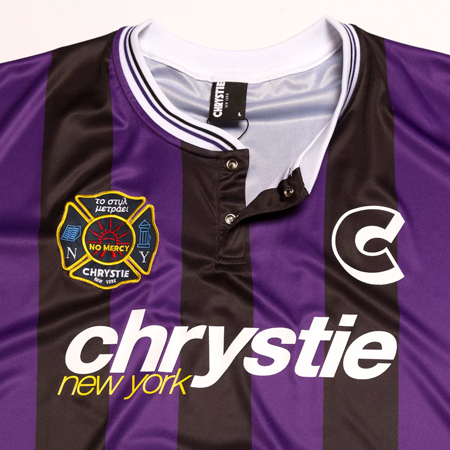Following our 'On A Plate' Creative Soccer Culture Tour in New York, Tosin Makinde explores how styling football jerseys and other rituals signal terrace culture’s presence in the city, with insights from Scenes NY’s Lucas Capozzi-Shanks and other early adopters.
Recently at the gym, I went up to a gentleman and said “I love your kit.” I’m a Manchester United fan and he was sporting a training top from the club’s Vodafone era. “Oh I don't know who this is but it looks cool,” he replied and I laughed. Born in a Nigerian home in South London, I moved to Baltimore aged 11 and I’m now based in New York City (NYC) having played, refereed, and coached football before working in the sport. Football aka soccer is here I thought after that encounter, and there’s a growing consensus that terrace culture has made it across the Atlantic.
Emerging from the standing areas of 1970s and 1980s football stadiums — the so-called terraces — this culture is synonymous with English football and has a storied history. Impassioned fans known as scallies in Liverpool, casuals in London, and Perry boys in Manchester returned from European away days with FILA, Sergio Tacchini, Ellesse, and Stone Island, turning those spaces into impromptu fashion runways. The shift wasn't just about style and designer sportswear; it had a rowdy, spirited side powered by original chants, fierce rivalries, and epic showdowns, which heightened the match day experience. This mix of fashion, passion, and chaos evolved into a unique lifestyle.
In the USA, specifically New York City, terrace culture is still finding its footing, with football gaining popularity and adapting these traditions in a uniquely American way. There are some physical terrace-like spaces – at Atlanta United’s Mercedes-Benz Stadium, for example, fans gather in the Gulch, where drums beat, and personal style is on full display. New York City FC (NYCFC) and New York Red Bulls (NYRB) have their own rivalry, the Hudson Derby, which, while not as intense as its European counterparts, brings its own flavour to NYC. With the new NYCFC stadium's “Supporters Porch” promising over 3,400 safe-standing positions, terrace culture in NYC is set to evolve further.
Speaking at SoccerBible’s 'On A Plate' Creative Soccer Culture Tour in New York, Lucas Capozzi-Shanks, who founded football brand Scenes NY and plays in pick-up matches, shares his own theory about how terrace culture manifests in the Big Apple. "It’s everything that surrounds the game, quite literally around the field but figuratively as well—the collective soccer zeitgeist created by how people dress, show support, and create rituals around football.” This culture, he explains, is organically and democratically grown in places like fences, sidewalks, and bars—New York's own terraces. An emblem of this cultural fusion is the adidas Samba, iconic in the terraces of 1980s Liverpool and now a staple in NYC’s fashion scene. “I’ve been wearing Sambas since I was 14,” shares artist Mateo Arciniegas Huertas, another 'On A Plate' NYC event attendee, underscoring the style’s enduring appeal. “I keep wearing them.”
Where NYC’s terrace culture diverges from its European counterpart is the emphasis on football jerseys beyond TikTok trend Blokecore. “In America, football kits aren’t as sacred as they are elsewhere, so people switch kits frequently,” says Olu Alege, founder of research and strategy firm NO NOISE. “They’re an alternative to basketball, baseball, and American football jerseys, so wearing one shows others that you're a bit worldly.” Alege believes football jerseys integrate seamlessly into high fashion, a trend driven by football’s influence on fashion. A Manchester United fan who’s experienced the Old Trafford atmosphere, he sees NYC’s embrace of terrace culture through fashion and kits as a positive evolution. Aimé Leon Dore, for example, keeps breaking new ground after taking their seminal ‘The World’s Borough’ campaign, which featured Arsenal players Declan Rice and Leah Williamson, to London for Spring / Summer 2024. Then the streetwear brand teamed up with long standing partner New Balance and England’s Bukayo Saka to create a football boot that the winger has worn at Euro 2024.
Rinaldy Alvarez, an active participant in NYC’s football leagues, appreciates that local football culture is growing from the grassroots. “I can’t say that NYC has fully embraced football, but there is definitely a lot of room for it here. You play what’s available to you, so the more pitches (or small side cages) pop up the more people will utilise them.” This bottom-up evolution is community-driven, with local support and representation gradually increasing. An example of this is the Daily Paper flagship store run by Clayton and Chris Griggs. The brothers often host watch parties and bring in footballers such as USMNT’s Tim Weah to mix and mingle with fans. “Yes, it can feel performative at times, but let people enjoy how they enjoy it. If you’re a true fan of the game, you’ll stay a fan when the performance ends,” Alvarez adds.
Ultimately, NYC’s terrace culture is an ever-changing landscape that is still defining itself daily. Football's trendiness draws some in, while others have a deep-rooted passion for the sport. I can vividly recall my first match at the original Wembley Stadium on November 16, 1994, England vs Nigeria. The kit Nigeria wore that day, a one-off, left a mark and solidified football’s place in my heart. This trend has evolved into a lifestyle, with fans proudly wearing their favourite team’s gear and adding their own unique touches – I mix my own football kits with designers such as Issey Mikaye for example. Balancing this enthusiasm while maintaining the sport’s essence is crucial and embracing new voices and perspectives is essential.
As European elements of terrace culture take hold stateside, it’s worth noting that the reverse is happening in Europe, as American sports capture international audiences. Besides the rise in American football club owners such as LA Dodgers owner Todd Boehly at Chelsea, AC Milan now has Club 1899, a ‘courtside’ VIP section, while American-owned Crystal Palace hired Kenny Annan-Jonathan as the Premier League's first ever Creative Director. Jeremie Frimpong gifted his league-winning Bayer Leverkusen teammates NBA style championship rings, and the FC Barcelona men’s and women’s teams are the first to really own the ‘tunnel fits’ phenomenon across the Atlantic.
The future holds immense opportunities for NYC’s terrace culture. Upcoming events like the Club World Cup, and the 2026 World Cup offer room for growth, fresh perspectives, and diverse cultural contributions. Aaron West, an on-air personality at CBS Sports Golazo, is sure that the World Cup 2026 will transform NYC “into a fully football mad city and I’m excited to see how much it stays that way after the last kick of a World Cup ball.” Terrace culture will continue to evolve here, blending fashion and passionate support for the game. Initiatives like FC Harlem, which provides opportunities for underrepresented kids, also exemplify inclusivity and foster community engagement, sparking interest in football among those who might not otherwise be exposed to it. Football in NYC isn’t just a sport; it’s a testament to the city’s dynamic and diverse spirit. The burgeoning terrace culture only enhances the beauty of the game, making it more vibrant and inclusive.
Photography Phil Provencio







